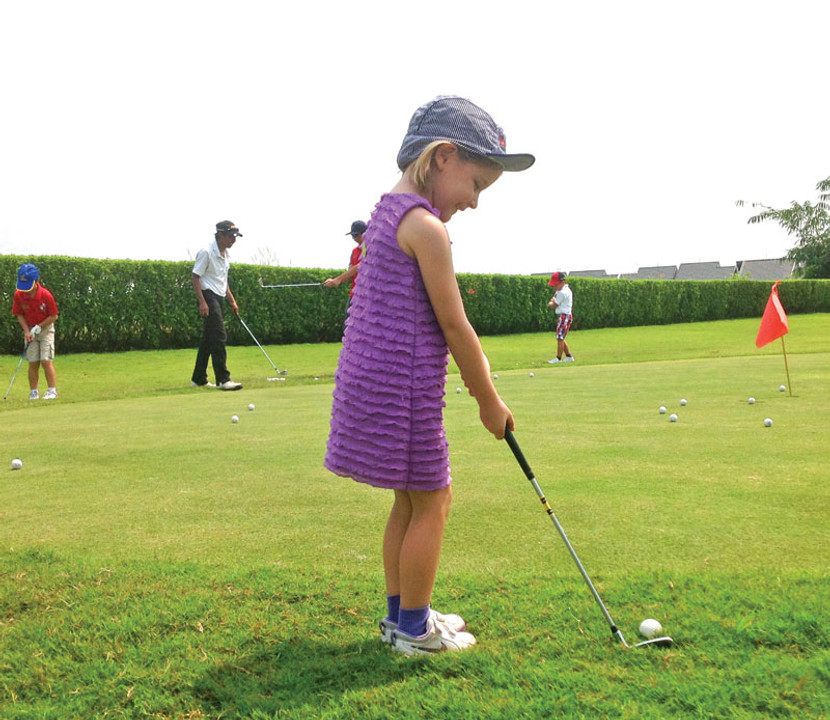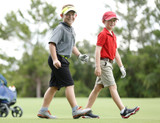Golf Tips for your Golf Backswing by Lea Hairson
Golf Tips for your Golf Backswing
by Lea Hairson
By the time your golf swing reaches the top, your left hand will have gone from a palmar flexion to a radial deviation without any effort on your part. It is the natural tendency. The only thing you have to watch is that it doesn't go too far and fall into a backward flex.
So why not use the break that brings you to the top naturally in the right position, instead of a break that you have to control carefully or manipulate? If you're working on improving your golf backswing and are looking for a new kids golf set, or your first junior golf set, feel free to checkout all of our junior golf sets, we have the largest selection of kids golf clubs in the U.S!
Without going any further into anatomical details, it can be stated flatly that the longer the backward wrist break is delayed on the backswing, the more difficult it becomes to make it correctly. The later this break takes place, the more liable we are to let the left hand bend backward, thus getting it under the shaft at the top and opening the face of the club. So, make the break early.
If you start making the wrist break as soon as the club leaves the ball, you will find it does a surprising number of things. We'll list them:
1. Sets you in the proper hand-wrist position early. (All you have to do is hold it.)
2. Any manipulation you have to do with your hands and the club is done early and in your full view.
3. Gives you the feeling that you have plenty of time to go to the top of your swing and come down.
4. Starts your swing in the right plane.
5. Immediately brings the right elbow in tight.
6. Prevents a "bouncing" club head at the top.
7. Tends to shorten the swing, thereby providing a brace against overswinging.
8. Gives you a feeling at the top that you have to move the body in order to get the club down to the ball. (Reduces inclination to hit from the top.)
9. Tends to bring the club to the ball with the wrists leading, as they should be.
10. Kills any temptation to pronate or supinate.
11. Promotes-almost insures-a late hit.
12. Promotes solid contact on the center of the club face.
The first three points are probably the most important. The others stem chiefly from the first three.
One of the most difficult things for the average golfer to master is the proper hand and wrist position at the top. At least one reason this is difficult is that, with the orthodox late break, the average golfer is always trying to get into it after the swing is in full motion. The early break sets his hands in the proper positions by the time they are hip high.
Another value is that this break divorces your mind from the club head. In the orthodox late break, with what has been called the one-piece takeaway, the player is thinking of moving hips, hands, and club head all at the same time. The fact that he is thinking of the club head at all is dangerous.
With the early break completed, there comes a feeling of time to spare. Nothing else needs to be done, except to swing the club to the top and bring it down. The hands will be right, the wrists will be right, the face of the club will be right-all you have to do is swing.
This feeling of what might almost be called serenity, plus points 4, 5, and 6, all contribute to getting you to the top of the swing in an excellent position. And the right position at the top goes a long, long way toward insuring a good downswing.
All Quiet at the Top
One reason that the early break seems almost to keep us from hitting too soon is that with it we reach the top with a controlled, "quiet" club head. With the ordinary wrist break, which is late, the club head moves quite fast in the late stages of the backswing. It moves fast enough, in fact, to exert a strong pull on the hands and wrists as it reaches its backward limit. It's momentum, actually, is checked only by the resistance of the hands and wrists to this pull.
As a result, in answer to this resistance of the hands and wrists, there is a quick rebounding of the club back toward the ball. Try it and you'll see what we mean. Since the average player usually lets the backward pull loosen his grip, he quickly re grips on the rebound, producing, almost, a "bouncing" club head. This starts the head of the club back toward the ball much faster than it should be moving at this point. This is one reason, and a strictly mechanical reason, why so many of us hit from the top.
The author is an avid golfer. He is a trainer and player, and has given expert golf lessons for a number of years.
To learn more about the golfing style of the author check out Golfing Tips
Expert Golf Guide
-
Do Kids Need to Wear Golf Shoes?
Jun 05, 20252025 Guide for Kids Golf Shoes Since 1988, here at AllKidsGolfClubs.com, we have been perfecting our
-
A 2025 Guide to Junior Hybrid Golf Clubs
Feb 10, 2025The Expert Guide for Junior Hybrids If you are thinking about adding a club or two to your kids golf
-
2025 Guide On Kids Golf Clothing Fashion & Trends
Jan 03, 2025Know the Trends, Essentials, and Fabrics for Your Kids Golf Apparel There’s a lot to consider when b





